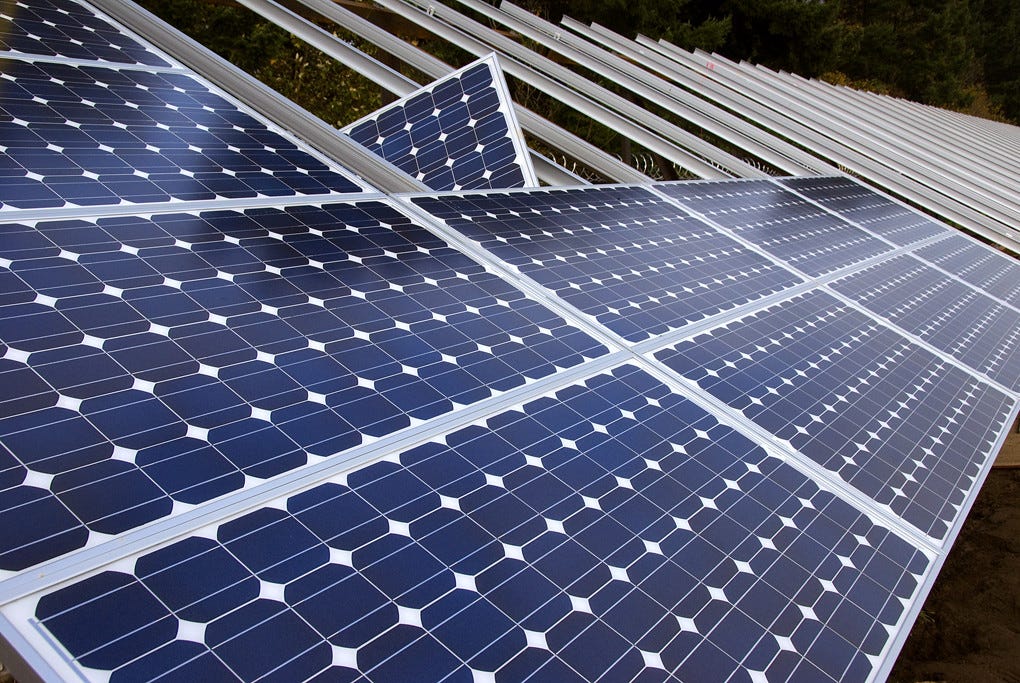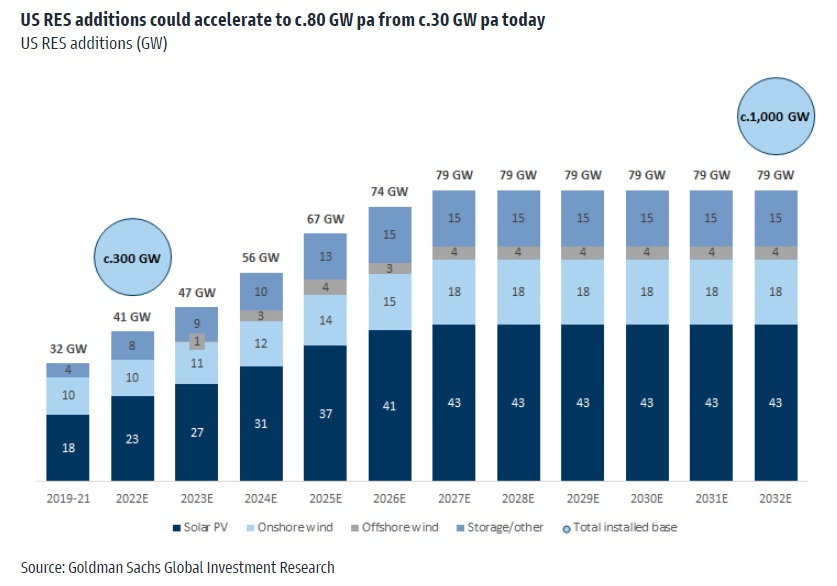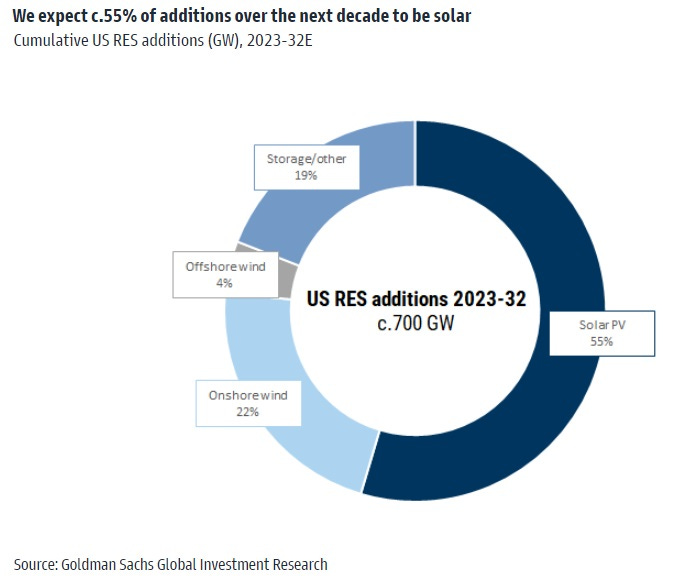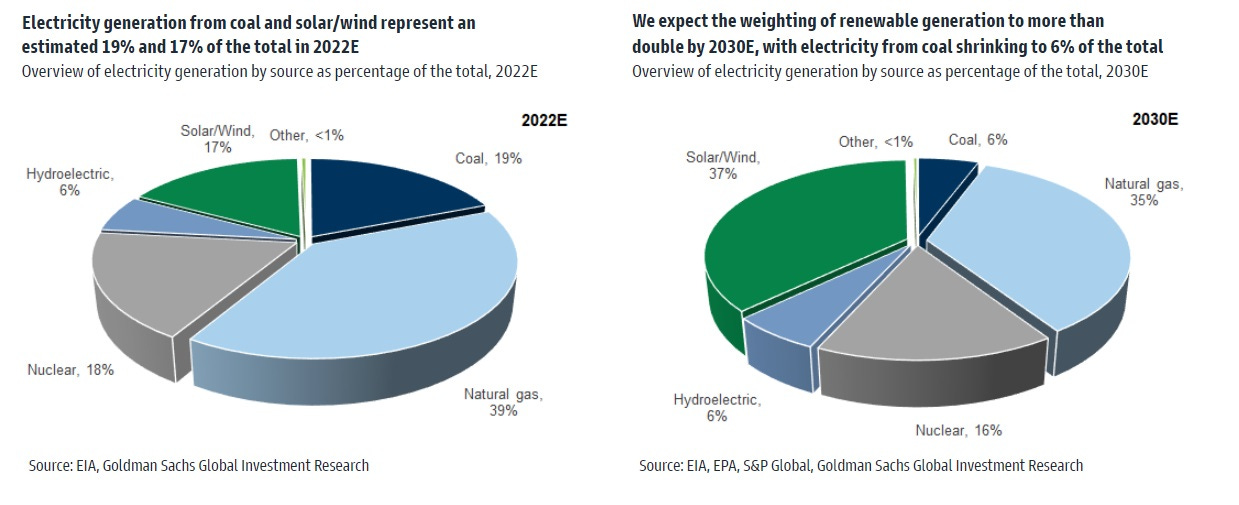💥 Tyler Cowen on the state of the Great Stagnation, pro-progress policy, metascience, and more!
Also: Don't listen to Noah Smith. I don't hate solar power.
In This Issue
5QQ: 5 Quick Questions for … Tyler Cowen on the state of the Great Stagnation, pro-progress policy, metascience, and more!
The Essay: Don't listen to Noah Smith. I don't hate solar power.
Micro Reads
Quote of the Issue
"For all its cruelties, civilization is precious, an experiment worth continuing. It is also precarious: as we climbed the ladder of progress, we kicked out the rungs below. There is no going back without catastrophe. Those who don’t like civilization, and can’t wait for it to fall on its arrogant face, should keep in mind that there is no other way to support humanity in anything like our present numbers or estate." - Ronald Wright, A Short History of Progress.
5QQ
💡 5 Quick Questions for … Tyler Cowen on the state of the Great Stagnation, pro-progress policy, metascience, and more!
On Thursday, I moderated a panel discussion at AEI, “Metascience for the Public: Policy Solutions to Flagging Productivity,” with an absolutely fabulous group of experts: Stanford University economist Heidi Williams, George Mason University economist and Bloomberg Opinion columnist Tyler Cowen, and AEI Senior Fellow Tony Mills. There was so much good stuff that came from the discussion that I wanted to use this newsletter to highlight some of it. So using my 5QQ format, I’m starting with the insights and observations of Tyler.
1/ To what extent do you think how we do science impacts science productivity and has played a significant role in the relative stagnation of productivity growth and economic growth over the past half century?
There's a commonly noted productivity slowdown in the Western world starting in 1973 that I and some other people here have written about. I think one neglected factor behind this slowdown is just the destruction of the German-language speaking and central European scientific world, which starts in the 1930s and culminates in World War II. On top of that, you have the Holocaust. The fruits of science take a long time. So if you're entranced with AI, that is ultimately the result of someone earlier having come up with electricity — Tesla, Edison, others. So before the 1930s, central Europe and Germany is by far the world's most productive scientific area. And which factors organizationally were behind those successes? To me, that feels dramatically understudied. But you have a 10-, 15-year period where essentially all of that goes poof. Some of it comes over here to the US, a bit to Great Britain, but that's really a central event in the 20th century. You can't understand 20th century science without thinking very hard and long about that event.
But in terms of more approximately and more recently, here's how I would put the importance of metascience or how science is done. It's how science is done better that will get us out of the Great Stagnation. I don't think that doing it worse is what got us into the Great Stagnation. So when it comes to what got us into the Great Stagnation, I think the number one culprit is simply we exhausted a lot of low-hanging fruit from combining fossil fuels with powerful machines. At some point, enough people have cars and you get the side airbag. Your CD player has better sound, now you hook in your smartphone or whatever. Those are nice advances, but they're not really fundamental to the act of driving. So there's just an exhaustion that happens.
There are other factors, there's an increase in the level of regulation in a number of ways, some good, some bad, but it's still going to slow down some amount of progress. And then the energy price shock in 1973 combined with our unwillingness to really go large with nuclear power, right?
There are other factors, there's an increase in the level of regulation in a number of ways, some good, some bad, but it's still going to slow down some amount of progress. And then the energy price shock in 1973 combined with our unwillingness to really go large with nuclear power, right? So all that happening more or less at the same time. And then a few decades earlier, the world took this huge, you know, wrenching gut blow. Now this all means actually, you should be quite optimistic about the future. Here's the trick to the whole hypothesis, the counterintuitive part. So let's say the Great Stagnation is not caused by science being done worse. As we're probably now coming out of the Great Stagnation, we have mRNA vaccines, right? We have ChatGPT, a lot of advances in green energy. Maybe they're not all sure things yet. Other areas like quantum computing, not a sure thing yet, but you can see that a lot might be coming all based in this new fundamental technology. You could call it computing.
So the hurdle that science has to clear to get us out of those accumulated institutional and low-hanging fruit barriers, that's a higher hurdle than it used to be. So if the current scientific advances are clearing that higher hurdle, you should actually be quite optimistic about them because they've passed through these filters. So you have these other developments. Oh, ‘90s internet becomes more of a thing. Well, that was nice for a few years, you know, Walmart managed its inventory better. 1995 to 1998 productivity goes up, wonderful. That dwindles away. It's then all worse again. If we really are now clearing all the hurdles, you should be especially optimistic. But it also means science policy, how science is done, how it's organized, how it's funded is way more important than during all those years. Those years when we were stuck, you were reshuffling the deck chairs. Not on the Titanic, but what's like a mediocre company that just keeps on going. I don't want any name names, but there's a bunch of them. You were reshuffling the deck chairs there, and now we're reshuffling the hall enterprise. It's a very exciting time, but science matters more than ever.
2/ Do we think enough about the economics of science and metascience?
For the economics profession, I would estimate, the economics of science is less than 1 percent of the total. I think it should be at least 10 percent of the total, we actually call it, for those of you who know, the Solow residual, like where ideas come from, it's residual. That's crazy. It's the most important thing in an economy. And we talk about it as some kind of residual rather than studying it. Huge oversight, no excuse for that. But in terms of policies for science, a few simple points: the best policy for science is just more immigration into the United States. High skilled maybe, but just flat out more immigration.
Second point, and this is really more for the private sector than the public, but I think still 13- to 19-year-olds are grossly underrated in areas where you can measure performance such as chess. You see 14-year-olds, 15-year-olds doing so much better than they did 20 or 30 years ago. Mostly that's the internet. In science, they're so much more advanced than they used to be. Current American foundations for the most part are not really geared up to be supporting or encouraging 13- to 19-year-olds. That is where a lot of the low-hanging fruit is. And it's when people make career decisions, their priorities, their interests, their trajectories.
So foundations, governments say all of this money spent has to be spread out. I think that's a pretty evil view actually. It's obvious where it comes from. It's hard to see it as evil, it sounds and feels fair, but I think we need to be unabashedly not afraid to double, triple down on supporting the clusters of excellence
Finally, I would make a point about clustering. We've grown afraid of clustering and Congress is part of the reason why. So before I was here, I was at the National Gallery looking at art. I'm in the Italian section. What's the first thing you notice if you're not asleep, is how many of the paintings come from either Venice or Florence, right? That's actually a pretty natural fact. If you think about the recent AI, LLM revolution, it's remarkable how much of it comes from the Bay Area. There's a role for Toronto, a role for Oxford, but it's pretty concentrated. So foundations, governments say all of this money spent has to be spread out. I think that's a pretty evil view actually. It's obvious where it comes from. It's hard to see it as evil, it sounds and feels fair, but I think we need to be unabashedly not afraid to double, triple down on supporting the clusters of excellence and walk on over to the National Gallery and take seriously the Italian paintings basically are all from Florence and Venice.
3/ What do you think of the notion that mimicking the Defense Advanced Research Projects Agency everywhere throughout the government R&D complex is a smart way to boost research productivity? DARPA for everything.
These would be my reservations about the DARPA model. … I think DARPA has worked as well as it has because it has the military behind it. And it's the same reason why the state of Virginia can't grab resources from the Pentagon the way the state of Alaska does from its oil funds. You lose a lot of political debates to the military no matter what. So as insofar as you multiply DARPAs, they're not going have the military behind them in the same way. Still probably is worth doing. But that would be a cautionary note.
But I would make the broader point. If you look at the history of invention, we could talk about Florence and Venice again, if you want, or dramatic science starting in the late 19th century. You have all these other models that at times work incredibly well and then don't work at all. And a lot of them are mysteries. So you need mentally to be prepared for the notion that a model that works incredibly well then doesn't work at all.
I tend to focus a bit more on the talent base of what you have access to in your society as the key issue for scientific funding.
Florence today is a center of the arts, but aside tourism, how big a deal is it? Close to nothing, right? Even much earlier you get essentially Milanese and French domination of the city, the decentralized struggles for power amongst the guilds that commissioned artworks to get political status, influence, and rent seeking. That whole dynamic went away. Something about the training base for artists being rooted in goldsmiths that went away. So I tend to focus a bit more on the talent base of what you have access to in your society as the key issue for scientific funding. And some of DARPA might have happened anyway, but in other places. So I'm all for DARPA, but those would be my caveats.
4/ What might be one relatively simple reform to boost science productivity?
I would internationalize more. The United Kingdom has a greater ability to run certain kinds of trials because they have an NHS and they gather a lot of data. Whether you like that system or not, it seems to me we should free ride upon it more. They're hard pressed for money. We should sort of hire them to do some of our work in a way that doesn't happen now. And in essence, pre-purchase clinical trials from them done in a faster way. You could imagine other countries such as Singapore, maybe you're not in a position today to do this, but you can imagine them getting there more quickly than we ever could with our, you know, thicket of laws and regulations and federalism and just cut a deal with Singapore. “Here's your money. You know, do the trial, get back to us when you're done. You know, we'll accept your results as valid, no FDA-based racism.” And do it that way if you can't win the domestic battles.
5/ Do you think boosting federal science funding to the sorts of levels that we had during the space race, I think like 2 percent of FDP — does that sound like a good idea?
You need to use it as a lever to enforce reforms. So I could imagine that doing it flat out would pass a cost-benefit test, but that's the lever you have. And if you spend that lever and you don't get improvement on procedures, in the longer run, you're coming out much worse. So I say make it contingent on real reforms, new institutions. It's such a deeply rooted problem. It's very hard to unpack all of the obstacles facing clinical trials, which probably are the number one issue, but all the different levels of delay and veto points to fix those all are very, very difficult. So this is our chance to do it.
The Essay
☀️ Don't listen to Noah Smith. I don't hate solar power.
What is the energy source of America’s future? I’m sure this will surprise some regular Faster, Please readers (including my pal and fellow Substack writer Noah Smith of the must-read Noahpinion who likes to kid me on Twitter for a supposed anti-solar bias), but the answer is … wind and solar energy. And to be clear, not solar energy collected by vast space-based, satellite mirrors, reflected onto panels, transformed into laser or microwave energy, and then beamed to Earth-based collectors. Nope, I’m talking photovoltaic panels based right here on terra firma. You know, those bad boys in the above image.
OK, I have so far left out one tiny, little baby, insignificant detail: my definition of “future.” Defining the timescale here as, say, ten years hence, makes my prediction a low-risk one. That’s just not very much time to utterly transform how a $23 trillion economy is powered (though big changes can happen).
Also making this a safe forecast: the recently passed Inflation Reduction Act. The $386 billion for clean energy subsidies — mostly in the form of expanded and new tax credits — is a pretty sizable chunk of change. Goldman Sachs thinks that spending could drive some $1.5 trillion in capital mobilization in clean energy, broadly, through 2023, including $675 billion in renewable investment. “If successfully implemented, the US IRA would go a long way to ‘Electrify America.,’ … [which could] also cement the gap between US and EU energy bills (currently at c.60%), potentially causing a further de-industrialisation of Europe.”
As far as additions to wind, solar, and storage, GS estimates the IRA will boost additions of new capacity to roughly 80 GW per year versus 30 GW over the past three years. GS: “Over 2023-32, this would imply cumulative additions of c.700 GW, which would more than triple the 2022 installed base to about 1,000 GW by 2032,” with more than half coming from solar.
And, as I said, you don’t transform a country’s energy sourcing and infrastructure overnight — even with massive cost reduction in the underlying technology, famously the case with solar — big changes can happen, as this next chart shows:
Solar and wind double, coal falls by two-thirds. That’s a significant change! And that change will have a not inconsequential impact on US carbon emissions, which is the point of all that spending. Again, GS (bold by them):
On the back of greater expected solar/wind generation, carbon capture, and electric vehicle sales over the next decade, we now assume a swifter pace of US carbon dioxide emissions reductions relative to our outlook for US carbon dioxide emissions from May 2022. We now see a 39% reduction in 2030 vs. 2005 levels, which implies 2%-5% annual reduction post an expected yoy increase in 2022 and modest decrease in 2023.
While the reduction in our base case is significant, it is short of the 50%-52% rate President Biden is targeting for overall greenhouse gas emissions. We highlight an illustrative upside case scenario for carbon dioxide emissions that, in aggregate, approaches but does not reach a 50% decline.
As a result of our analysis, we believe it is likely that emissions from the power sector will not have fallen 75% by 2032 vs. 2022 levels, meaning certain IRA incentives could extend beyond 10 years.
So what we have is a classic “a bird in the hand is better than two in the bush” situation, where the two in the bush are the future energy sources I often write about: nuclear fission from small reactors, nuclear fusion, advanced geothermal, and even space-based solar. Solar and wind are being installed, while those others are still being developed and demonstrated rather than being plugged into the grid. That’s just the reality.
Take the case of nuclear SMRs, or small modular reactors, which offer the promise of cheaper, quicker to build, and safer nuclear energy. A scan of new headlines might make you think we’ll soon be dismantling coal plants and popping in SMRs at those locations. This sort of headline, in particular: “U.S. approves design for NuScale small modular nuclear reactor.” According to a Reuters story from last month, the approval from the Nuclear Regulatory Commission is the first for an SMR design. (NuScale plans to build a demonstration plant at the Idaho National Laboratory and says the “six-reactor, 462 megawatt Carbon Free Power Project will be fully running in 2030,” according the piece.)
But the path forward to grid power might be closer to the end of the beginning than the beginning of the end. An excellent MIT Tech Review piece explains:
Receiving a final ruling for the design means that NuScale would only have to get approval for a reactor site and complete final safety reviews before beginning construction. So in theory, NuScale has already cleared the hardest regulatory steps required before building a reactor. … There’s an additional wrinkle: NuScale wants to tweak its reactor modules. While the company was going through the lengthy regulatory process, researchers were still working on reactor design. During the process of submission and planning, the company discovered that its reactors could achieve better performance. … The upgraded power rating requires some adjustments, but the module design is fundamentally the same. Still, it means that the company needed to resubmit updated plans to the NRC, which it did last month. It could take up to two years before the altered plans are approved by the agency and the company can move on to site approval, says Jose Reyes, cofounder and chief technology officer at NuScale.
Again, there are no SMRs running in the US yet, no SMRs generating electrons to charge our phones. The same can’t be said of solar and wind. It’s my hope, of course, that story will eventually change. It will need to if we want a high-energy planet with a stable climate where living standards everywhere can one day be as high as they are in advanced economies today. Real talk from ChatGPT, which is apparently a member of #TeamAllOfTheAbove:
In theory, the amount of energy that could be generated by solar power is virtually limitless, as the sun provides a constant source of energy. However, the practical ability of solar power to provide the energy that humanity needs in the future will depend on a number of factors, such as the efficiency of solar panels, the amount of usable land and resources available for solar power generation, and the effectiveness of energy storage solutions. It is unlikely that solar power will be able to provide all of the energy that humanity needs in the future, especially as energy demand continues to increase.
Micro Reads
▶ SpaceX completes a hot fire test of its massive Super Heavy rocket - Eric Berger, Ars Technica |
▶ ChatGPT is everywhere. Here’s where it came from - Will Douglas Heaven, MIT Tech Review |
▶ I Tried Microsoft’s New AI-Powered Bing. Search Will Never Be the Same. - Joanna Stern, WSJ |
▶ German Doctors Are Attempting to Reverse Death and Resurrect Humans - Tim Newcomb, Popular Mechanics |
▶ Regulation, Productivity and the Meaning of Life - Paul Krugman, NYT Opinion |
▶ Can China Reverse Its Population Decline? Just Ask Sweden. - Andrew Jacobs and Francesca Paris, NYT |
▶ DARPA, lasers and an internet in orbit - The Economist |






